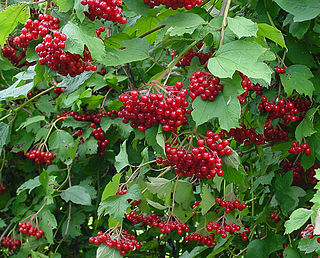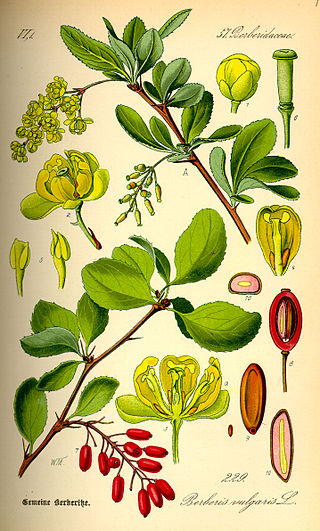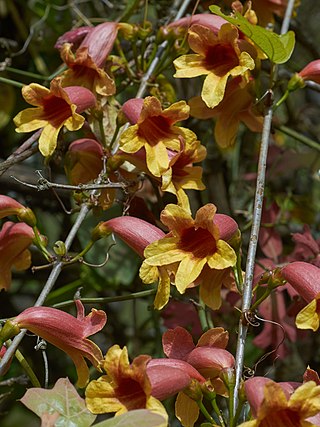
Guava is a common tropical fruit cultivated in many tropical and subtropical regions. The common guava Psidium guajava is a small tree in the myrtle family (Myrtaceae), native to Mexico, Central America, the Caribbean and northern South America. The name guava is also given to some other species in the genus Psidium such as strawberry guava and to the pineapple guava, Feijoa sellowiana. In 2019, 55 million tonnes of guavas were produced worldwide, led by India with 45% of the total. Botanically, guavas are berries.

Viburnum is a genus of about 150–175 species of flowering plants in the moschatel family, Adoxaceae. Its current classification is based on molecular phylogeny. It was previously included in the honeysuckle family Caprifoliaceae.

Magnolia grandiflora, commonly known as the southern magnolia or bull bay, is a tree of the family Magnoliaceae native to the Southeastern United States, from Virginia to central Florida, and west to East Texas. Reaching 27.5 m (90 ft) in height, it is a large, striking evergreen tree, with large, dark-green leaves up to 20 cm long and 12 cm wide, and large, white, fragrant flowers up to 30 cm (12 in) in diameter.

Coccoloba uvifera is a species of tree and flowering plant in the buckwheat family, Polygonaceae, that is native to coastal beaches throughout tropical America and the Caribbean, including central & southern Florida, the Bahamas, the Greater and Lesser Antilles, and Bermuda. Common names include seagrape and baygrape.

Labrador tea is a common name for three closely related plant species in the genus Rhododendron as well as a herbal tea made from their leaves. All three species are primarily wetland plants in the heath family. Labrador tea has been a favorite beverage for a long time among the Dene and Inuit peoples.

Aralia spinosa, commonly known as devil's walking stick, is a woody species of plant in the genus Aralia of the family Araliaceae. It is native to eastern North America. The various names refer to the viciously sharp, spiny stems, petioles and even leaf midribs. It has also been known as Angelica-tree.

Annona squamosa is a small, well-branched tree or shrub from the family Annonaceae that bears edible fruits called sugar apples or sweetsops. It tolerates a tropical lowland climate better than its relatives Annona reticulata and Annona cherimola helping make it the most widely cultivated of these species. Annona squamosa is a small, semi-(or late) deciduous, much-branched shrub or small tree 3 to 8 metres tall similar to soursop. It is native of tropical climate in the Americas and West Indies, and Spanish traders aboard the Manila galleons docking in the Philippines brought it to Asia.

Eugenia uniflora, the pitanga, Suriname cherry, Brazilian cherry, Cayenne cherry, cerisier carré, monkimonki kersie,ñangapirí, or shimarucu is a flowering plant in the family Myrtaceae, native to tropical South America’s east coast, ranging from Suriname, French Guiana to southern Brazil, as well as Uruguay and parts of Paraguay and Argentina. It is often used in gardens as a hedge or screen. The tree was introduced to Bermuda for ornamental purposes but is now out of control and listed as an invasive species. The tree has also been introduced to Florida.

Osmanthus is a genus of about 30 species of flowering plants in the family Oleaceae. Most of the species are native to eastern Asia with a few species from the Caucasus, New Caledonia, and Sumatra. Osmanthus has been known in China since ancient times with the earliest writings coming from the Warring States period; the book Sea and Mountain. South Mountain states: "Zhaoyao Mountain had a lot of Osmanthus".

Chrysobalanus icaco, the cocoplum, paradise plum, abajeru or icaco, also called fat pork in Trinidad and Tobago, is a low shrub or bushy tree found near sea beaches and inland throughout tropical Africa, tropical Americas and the Caribbean, and in southern Florida and the Bahamas. An evergreen, it is also found as an exotic species on other tropical islands, where it has become a problematic invasive. Although taxonomists disagree on whether Chrysobalanus icaco has multiple subspecies or varieties, it is recognized as having two ecotypes, described as an inland, much less salt-tolerant, and more upright C. icaco var. pellocarpus and a coastal C. icaco var. icaco. Both the ripe fruit of C. icaco, and the seed inside the ridged shell it contains, are considered edible.

Berberis vulgaris, also known as common barberry, European barberry or simply barberry, is a shrub in the genus Berberis native to the Old World. It produces edible but sharply acidic berries, which people in many countries eat as a tart and refreshing fruit.

Triphasia trifolia is a species of Triphasia in the family Rutaceae, native to tropical southeastern Asia, especially in Indonesian islands and Philippines and possibly elsewhere.

Pittosporum obcordatum, commonly called heart-leaved kohuhu or heart-leaved kohukohu or kohukohu, is a species of plant in the Pittosporaceae family. It is endemic to New Zealand, and is found both in the North Island and the South Island.

Myrica cerifera is a small evergreen tree or large shrub native to North and Central America and the Caribbean. Its common names include southern wax myrtle, southern bayberry, candleberry, bayberry tree, and tallow shrub. It has uses in the garden and for candlemaking, as well as a medicinal plant.

Bignonia capreolata is a vine commonly referred to as crossvine. The common name refers to the cross-shaped pattern revealed when the stem is cut; this pattern results from four radial wedges of phloem embedded within the stem's xylem. It is native to the central and southern United States. The vine climbs without twining but does produce tendrils. It produces long tubular flowers which are red and yellow and frequently have a mocha fragrance. The leaves are dark green to almost purple and produced as opposite pairs with terminal tendrils. The vine often climbs very high, with leaves only remaining on the uppermost portion of the plant. Crossvine can spread aggressively through stolons and may need to be managed in garden or domestic settings.

Piscidia piscipula, commonly named Florida fishpoison tree, Jamaican dogwood, or fishfuddle, is a medium-sized, deciduous, tropical tree in the Fabaceae family. It is native to the Greater Antilles, extreme southern Florida and the Bahamas, and the coastal region from Panama northward to the vicinity of Ocampo, Tamaulipas, Mexico. The native Taino of the West Indies discovered that extracts from the tree could sedate fish, allowing them to be caught by hand. This practice led to the tree's common names—fishpoison and fishfuddle. The tree has medicinal value as an analgesic and sedative.

Clerodendrum tomentosum, known as the downy chance, hairy lolly bush, hairy clairy or hairy clerodendrum is a shrub or small tree occurring in eastern and northern Australia. It is distributed from Batemans Bay in southern coastal New South Wales, to Queensland, Northern Territory, Western Australia, and New Guinea.

Rhytidophyllum is a genus of plant in family Gesneriaceae, native to the Caribbean islands and northern South America.

Trema tomentosum, also known as T. tomentosa and commonly called poison peach, is a shrub or tree in the family Cannabaceae native to the Indian subcontinent, south east Asia, through the islands of the south west Pacific, and the east coast and northern half of Australia.


















